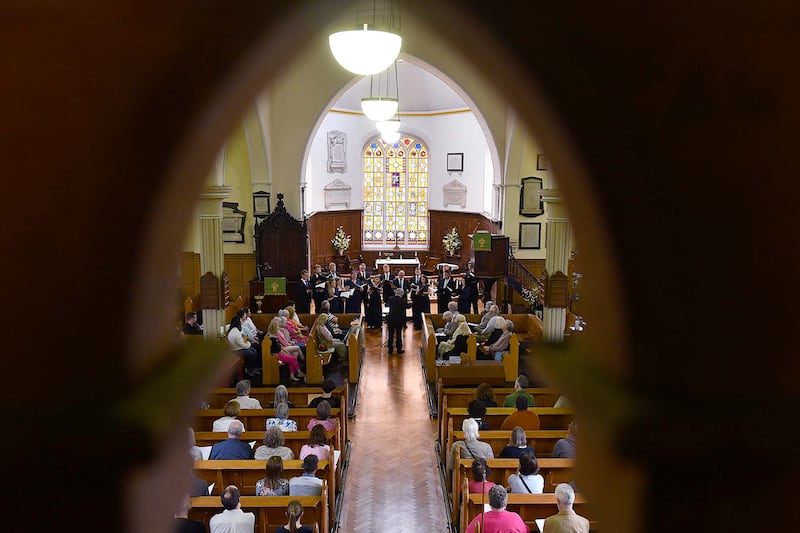Folks’ Music
Dundalk
★★★★☆
Folks’ Music, Louth Contemporary Music Society’s weekend festival, held in various venues in Dundalk, broke what might seem a pair of unspoken rules. It doesn’t usually repeat works that have been heard in earlier festivals, and it doesn’t usually reach back for repertoire from the middle of the 20th century.
But then Terry Riley’s In C, from 1964, a seminal work of early minimalism, is exceptional in any number of ways. There’s no score as such, just a single page of music that each performer works from. The page has 53 short patterns to be repeated in loosely aligned sequence to the background (or sometimes foreground) of a regular pulse.
In addition there are two pages of performing directions, running to about 600 words, to explain the dos and don’ts of performing the piece, which takes about an hour. The wording is mostly suggestive; even the pulse, one of the most characteristic aspects of most performances, is actually optional.
The second paragraph gives a flavour of the approach. “Any number of any kind of instruments can play. A group of about 35 is desired if possible but smaller or larger groups will work. If vocalist(s) join in they can use any vowel and consonant sounds they like.”
The couple who bought a Wicklow golf course and turned it into a native woodland
Brenda Fricker: ‘It was real violence, and I needed protection. Where was my father? There was blood all over me’
I could hardly breathe when I heard ‘Mum’s gone missing’, but then I knew what had happened
Students’ complicated relationship with AI: ‘Avoiding using it probably put me at a bit of a disadvantage’
Smaller groups are the norm nowadays, and the Dundalk performance had just seven, all of them traditional Irish musicians – Zoë Conway, Paddy Glackin, Dónal Lunny, Louise and Michelle Mulcahy, Mick O’Brien and Máirtín O’Connor – with the sound of Lunny’s bouzouki providing the constant pulsing, though in a manner that was often cunningly decorated.
In C may have been cutting edge in the mid-1960s, but there’s also a sense in which it is a throwback to earlier centuries, when public concerts were rare and music was written primarily for the performers – in this case, especially those with the appetite for unpredictability.
On Saturday the timbre of the instruments alone would have made for a sound world probably unique in the work’s history. But also, on this occasion, the composer gave the players specific licence to do a bit of what they normally do, in terms of bending notes to their own taste and, beyond that, departing from the text to sidestep into some actual Irish tunes. It’s easy to imagine that the unusually genial composer would have loved it every bit as much as the audience clearly did.
Saturday’s earlier concerts included the Esposito Quartet in Caroline Shaw’s impeccably fashioned, retro-minimalist, tree-inspired The Evergreen and a set of rather twee songs with the composer as vocalist. The programme also included the first performance of Laurence Crane’s Beethoven-inspired Quartet No 2, a typically spare reordering of the familiar, playing delicately on subtle, almost subliminal listener expectations. This performance was peculiarly balanced, with the players relishing the expressive opportunity of lurching into recognisable Beethoven. The effect was like splashing bright sunlight into a space that reveals its secrets only when half-lit.
[ Laurence Crane: ‘I try to find new ways of making form and structure’Opens in new window ]
Nothing could be further from Crane’s world than the heft and impact of Sigma Project, a saxophone quartet from Spain who favour a line-up of two soprano and two bass saxophones. All dressed in pristine, priestly white, they played works by Jesús Torres, Helga Arias, Graciela Paraskevaídis and José María Sánchez-Verdú, and looked and often sounded as if they were engaging in some kind of arcane ritual. The playing was hugely impressive, from piercing shrieks to subwoofer-style weight at the opposite end of the spectrum.
Strangely, the effect was at its most rewarding in Torres’s Tenebrae, with its fragmented recollections of Spain’s great Renaissance composer Tomás Luis de Victoria. The other works seemed unable to escape from the obvious temptations that the peculiar combination of instruments provides.

The string quartets played by London’s Explore Ensemble in the Oriel Centre (which is to say Dundalk’s historic jail) were altogether lighter on the ear. Sam Perkin’s new Awe, with its Pseuds Corner programme note, was a disappointment, given that Perkin placed much emphasis on the film that was screened along with the music. I couldn’t see much because the screen was lost behind a sea of heads, and the projection was so ineffectual that anything I could see was washed out because of the room’s skylights.
The exploratory quartets by Clara Iannotta, A Failed Entertainment of 2013 and Dead Wasps in the Jam-Jar (III) of 2017, spent a lot of time in a world of scarcely audible whispering, scraping, whistling and brushing that somehow managed to remain engaging.
Explore Ensemble also offered the Canadian composer Cassandra Miller’s Leaving, a folksy gift to friends that was thoroughly outclassed by her new work, The City, Full of People, which ended Friday’s opening concert by Chamber Choir Ireland under Paul Hillier.
That concert opened with the Toronto resident Linda Catlin Smith’s Folio, which set shards of Emily Dickinson in a way that managed to seem both still and in motion, reserved and committed.
Caroline Shaw’s origami-inspired but not very inspiring How to Fold the Wind was finely done. But the big honours went to Miller’s setting of a single line from the Lamentations of Jeremiah, set for spatially separated voices, in a way that turned spatiality into a sensual experience all of its own. The angelic ending was what Virgil Thomson once described (in relation to Messiaen) as “an apotheosis destined at once to open up the heavens and to bring down the house”. Which it duly did.












